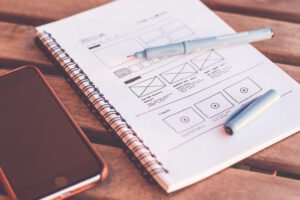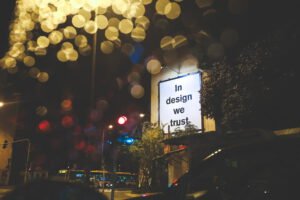What is UX/UI design? And what does UX/UI designer do?

Companies that build digital products strive to address the preferences of their customers as accurately as possible. That’s why UX and UI design jobs are on the rise. According to the analytics platform Burning Glass, the average time required to fill a UI or UX position is 41 days. This is a lot – and it means that the demand for jobs like that is high.
In this article, we zoom in on this role and show you what a UX/UI designer does and what it takes to become successful in this exciting field.
1. What is UX/UI design?
It’s common to use UI and UX interchangeably, but they are actually two different things.
UI (user interface) design is all about what users actually see on the application’s screen – text, colors, backgrounds, icons, and moving elements like animations. That’s why UI design overlaps with graphic design. The career path in UI design is quite similar to graphic design – graphic design education and experience in product development projects are a big plus for UI designers.
UX (user experience) design focuses on studying how users move through all the different elements of the UI. For UX designers, it’s all about the flow of the user experience and eliminating any sources of friction during these interactions. That’s why UX designers need to know the methods and tools for studying user behaviors – and then translate their insights into design guidelines or principles. A UX designer is responsible for making products usable, enjoyable, and accessible to users.
While UI handles the look of a digital product, UX handles how all of the UI elements work together to create a seamless user experience.
A UX/UI designer combines these two areas by carrying out user research first, and then implementing the findings in the visual design in the form of mockups, wireframes, and prototypes. These are then tested, and user feedback is gathered to inform further changes and bring the product to the greatest possible shape before the launch.

2. What does a UX/UI designer do?
The daily responsibilities of a UX/UI designer depend on the kinds of projects they work on, the company, team size, and priorities. While some designers focus on tangible products such as mobile apps or VR devices, others design the overall experience of staying at a hotel or using public transportation.
Your everyday tasks as a UX/UI designer depend on your exact role and the type of company you work for. The tasks range from more conceptual ones like research, testing, and business analysis, to more hands-on ones like wireframing and prototyping.
However, there are a few general functions that a UX/UI designer can be expected to perform. Here’s a short list of the typical things designers do at their jobs.
a) Carrying out user research
The initial phase in the UX design process is research. It can take different forms – from desk-based to field research. The goal is to get a full picture of the target audience for whom the product or service is intended.
- How do UX/UI designers research users? Here are a few example tasks:
- – Review of the current products or services offered by the competition.
- – Interviewing existing users to identify their pain points and preferences.
- – Creation of user personas, including all of the key details.
- – Detecting potential opportunities based on the findings of users.
All of these tasks allow the designer to identify the core features required for building the Minimum Viable Product (MVP). An MVP is the very first iteration of a product released to the public for the purpose of validating a business idea and gathering initial user feedback.
The user research phase helps teams to scope out the project, identify exactly who they’re designing for, and what the key user goals and challenges are in relation to the product.
b) Building user personas
Based on the user research, UX/UI designers create user personas that explore in more depth the particular tasks every persona wants to perform and why. A typical persona includes demographic data, as well as information about preferences, habits, likes, and dislikes, and connection to trends.
Another popular approach that can be used together with (or instead of) user personas is Jobs-To-Be-Done (JTBD). JTBD shifts the focus from the hypothetical user to what the actual users are looking to accomplish by using a product.
c) Crafting the information architecture
Next, designers usually start thinking about the kind of content they need to display in products or marketing materials. This is where they consider how all of the key information will be structured across the website or application. This is called information architecture – and crafting it is the task of working out the most logical content layout and organization.
Why is information architecture important? A good one ensures that the user can easily navigate the product/site, find what they’re looking for, and accomplish their goals quickly.
d) Creating user flows and wireframes
UX/UI designers use various tools to map out the user’s journey through a product. Two such tools are user flows and wireframes.
User flows are basic flowcharts that visualize the path a user takes when using a product, starting at the entry point right and ending with the final interaction.
Wireframes, on the other hand, offer a two-dimensional outline of a single application screen or page of a website. Designers support their wireframing process with many different tools that allow them to quickly create sketches and simple wireframes that communicate their intention.
e) Prototyping and user testing
Once designers have the product layout mapped out, they can move on to creating the first prototypes for running the initial user tests.
What exactly is a prototype? It’s a scaled-down version of the product that enables teams to test their designs before passing them over to development. Prototypes can be simple paper models, but also high-fidelity interactive prototypes that closely mimic the final product.
Testing prototypes on real users allows businesses to identify any design flaws before they invest in creating the final product. Note that several rounds of testing might have to take place before the design is spot on.
f) Participation in development
Once the product enters the development phase, designers are still part of the process. They attend sprint meetings, supervise product development to ensure that the team avoids feature creeps, and apply small refinements to the design whenever necessary. They also participate in designing features for new releases and analyze user feedback.
g) Visual design
Some UX designers also specialize in visual design – this is where they fill the role of a UX/UI designer. So they’re also the ones who make decisions about the final imagery, color schemes, icons, and typography.
3. What skills does a UX designer need?
To carry out such a varied range of tasks, UX designers need a diverse skillset:
- – Technical and design skills – wireframing and prototyping with the help of various digital tools.
- – Analytical skills – ability to interpret data and feedback correctly, problem-solving skills.
- – Empathy – the ability to step into the shoes of different types of users.
- – Communication and teamwork – working in a team is the most common setup for UX/UI designers, so they need to know how to collaborate with clients, stakeholders, developers, and even fellow designers.
- – Business acumen – ability to understand the business objectives and processes and aligning them with the needs of the target audience.
These skills are just that foundation. To become a successful UX/UI designer, you also need to know how to carry out user research, know the process of prototyping like the back of your hand, and be familiar with the fundamentals of good design.
The designers who truly distinguish themselves have skills that allow them to approach challenges holistically, using methods such as design thinking or data visualization.

4. How to become a UX/UI designer
Step 1: Understand your role
To get started, you need to first understand what you’d like to do since the field of UX/UI intersects with graphic design at many points:
- – If you like working on the visual part of the design, consider becoming a UI designer.
- – If you prefer to analyze how products work with users and test different interface options, you should become a UX designer.
- – If both directions seem attractive to you and you would also like to deeply understand the product and be in charge of its improvements, then the role of UX/UI designer or product designer is a good match.
Step 2: Master the tools for work
If you’re a beginner designer, you need to learn how to use the most important tools used today. Instead of opting for classics such as Adobe Photoshop and Illustrator, go directly to Sketch and Figma.
Take a look at the designer jobs offered by the companies you’d like to work for. What skills are they looking for? What programs do they want you to know? What are the industry standards in your field today? You need to know the answer to these questions.
Here are a few examples of the most popular tools for designers today:
- – Sketch for UI design
- – Figma for UI design with a useful collaboration feature
- – Balsamiq for building layouts
- – Invision App for creating prototypes and collaborating on them
- Step 3: Open your eyes to design
If you want to become a designer, you need to start noticing design around you and draw insights from everything you see. When visiting a website or using an app, pay attention to everything, and ask questions like:
- – Why is the Call-to-Action button at the end, and not in the beginning?
- – Why is the logo located at the top left corner of the page?
This will help you to understand industry standards and trends better and learn how to evaluate a website or app from a professional viewpoint.
Step 4: Find your style
If you want to become a UX/UI designer but have no experience or work degree, the best way to start is by understanding how others work. This doesn’t mean copying other people’s work, but rather getting inspired by what you see.
The habit of looking at the work of designers you admire is very productive at the beginning of your journey. You will learn to pay attention to certain details, understand how designers use different styles and elements, and – eventually – find your own style.
There are plenty of resources you can use, starting with platforms such as Behance, Dribbble, or Awwwards. This practice will help you position yourself on the design track and become aware of key trends in design.
Step 5: Find mentors
Experienced designers are usually busy and might have very little free time. Don’t ask them to teach you the ins and outs of Sketch or help you build your career in design. This takes way too much time.
Instead, find mentors who are already sharing their expertise in the form of blog articles, vlogs, and social network accounts. Subscribe to the channels curated by top designers that you like. Watch what they’re doing – what new programs they study and which conferences they go to.
Step 6: Take a course
While some people prefer to learn the secrets of a new profession at home through self-educating, others can benefit a lot from target online courses that teach the foundation of design.
If you’d like to take a course, research the company or school providing it first – check the reviews, comments, and ratings to understand how popular it is and whether it really helps graduates to launch a career in design.
Step 7: Create your portfolio
Lastly, you need to create a portfolio that shows off your skills. This is a must-have if you want to start looking for a job as a UX/UI designer.
For a designer, a portfolio works as a business card and resume in one. By looking at it, the employer will instantly know whether to start the interviewing process or choose another candidate who is a better fit.
You don’t need to have your own website. If you’re a beginner, you can simply register to an online platform and set up your page there. Behance and Dribbble are both great for beginners.
Conclusion
If you’re interested in UI and UX design, here’s some good news: we’re seeing a strong market for these skills at the moment. Develop solid technical and design, work on your soft skills, and research the newest design trends – that’s how you can enter the career path of a UX/UI designer.
If you’d like to learn more about building a career in the tech industry, keep a close eye on our blog – our experts share a lot of insights about how to find the best opportunities for a successful career.
